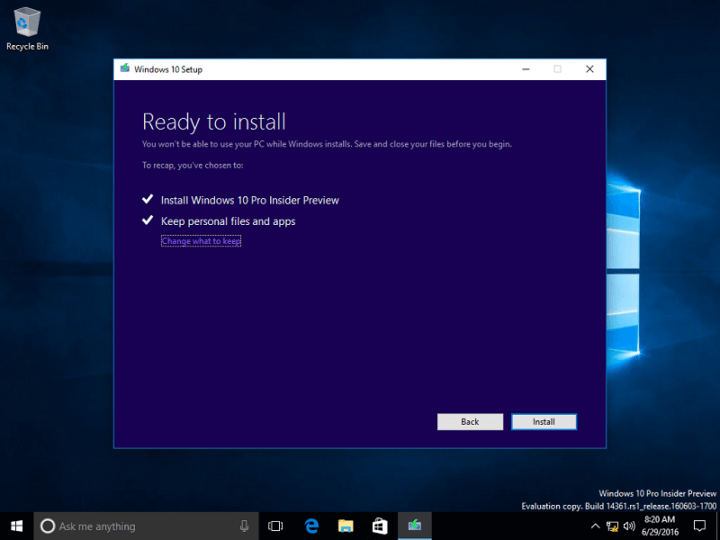Windows 10 Choose What To Keep
Hi,
Apologize for the delay in responding. When you select 'Keep nothing' during Windows 10 installation, only the data on the drive where Windows 10 is installed will be erased. Data on other drives will not be affected.
It seems that you have jumped the queue. It was always recommended to do an Upgrade to Windows 10 from Windows 8.1. Without doing an upgrade, a clean install of Windows 10 will be not activated. You need to have pre-qualified i.e. a Genuine Windows 7 SP1 or Windows 8.1 before upgrading to Windows 10. If you perform a clean install on first attempt, you will have to start over from an activated Windows 7 or Windows 8/8.1 installation.Refer to the following link by our esteemed MVP Andre for more detailed description about Activation in Windows 10:
Windows 10 setup automatically installs Windows 10 core (or Home) edition in their computer without giving any choice to choose between Home or Pro editions. In fact Windows 10 setup should ask users to select the edition type (Home, Single Language, Education, Pro, etc) at the installation time as shown in following screenshot.
Refer to the following articles to know more about Windows 10 and the steps that you need to take care before installing Windows 10:
Frequently Asked Questions: Windows 10
How To Block Windows 10 From Downloading
http://answers.microsoft.com/en-us/insider/wiki/insider_wintp-insider_install/frequently-asked-questions-windows-10/5c0b9368-a9e8-4238-b1e4-45f4b7ed2fb9
Hope I've answered your query in an appropriate manner. Get back for further queries.
Microsoft will have no choice but to give consumers free Windows upgrades once it launches Windows 10 and kicks off its fast-fast-fast tempo, an analyst asserted.
'If Microsoft wants consumers to update and keep up to date, it really means that Microsoft is going to have to give those consumers those updates for free. There's really no other way to do it,' said Michael Silver of Gartner at the research firm's annual technology conference.
'A consumer isn't going to give Microsoft a credit card and say, 'Charge me for a new release whenever one comes out,' Silver added. 'It's very likely that consumer releases will be free.'
That will affect Microsoft's bottom line: With Windows 10 expected to be the nameplate for the OS for years longer than the usual three-year cycle between major upgrades -- from Windows 7 to Windows 8, say -- free means that consumers will never again have to pay to upgrade their PC's OS.
A constant trickle of free updates and upgrades will also put computer makers in a bind, as historically they have relied on new editions to spark sales, particularly to consumers.
Silver's argument that Windows 10, if not free itself, must offer free updates to consumers, came during a 45-min. presentation where he and a colleague, Stephen Kleynhans, discussed the future of Office and Windows before a standing-room-only crowd at Gartner Symposium/ITxpo 2014. The research firm lets anyone view up to three on-demand video recordings of conference sessions free of charge, including the one with Silver and Kleynhans.
The two put Microsoft's Windows 10 and Microsoft's promise of a steady stream of updates in context for businesses, which have shied away from Windows 8 and are being coaxed back into the fold with promises that Windows 10 will be all that its predecessor wasn't.
'A lot of enterprises were expressing concern that they couldn't keep up with that faster cadence [of Windows 8 to Windows 8.1 to Windows 8.1 Update],' said Kleynhans. 'So, Microsoft decided to change things about the cadence. They've come up with a new, new cadence. Because you couldn't keep up with annual updates, they're going to go to monthly updates.'
That last line got a laugh from the audience, but it was more dark humor than levity: Businesses have balked at an accelerated update cadence. Microsoft got an earful last April from IT professionals, for example, when it told them they had just 30 days to install Windows 8.1 Update.
Microsoft has, however, made allowances for corporations. Rather than adopt what Silver and Kleynhans called 'consumer speed' updating -- a tempo that could be as frequent as monthly -- businesses will be able to delay deployment with a pair of alternate tracks.
The most conservative of those tracks, which Gartner has labeled 'long-term servicing,' will be of interest almost exclusively to enterprises.
'They're going to introduce the concept of a long-term serving update,' said Kleynhans. 'They'll take all of those [consumer speed updates] and roll them into a single release and that will be a stake in the ground. That stake in the ground will stay there for 10 years or so, we expect. And you'll be able to stay on that stake in the ground, that long-term servicing update, for as long as you need to. It will continue to get security updates, but features are going to be pretty much locked down and not change.'
For those who have been around Windows a while, the long-term servicing update cadence is analogous to how Windows was dealt out pre-Windows 8.
According to Silver and others, that slowest temp will also impact how Microsoft profits from its venerable OS: Corporate customers will have to pay for it.

'We expect that organizations that want the longest-term support, the one with no changes, are going to have to pay for that by buying a Windows Enterprise Upgrade license,' said Silver in an interview last week. 'They going to have to pay more.'
Wes Miller, of Directions on Microsoft, wasn't as certain as Silver about Microsoft charging for an unchanging Windows. 'I'm curious about that, but I think it's definitely possible,' Miller said in a recent interview. 'We saw that with XP, support isn't free.'
'The ironic thing is that enterprises used to buy Software Assurance and pay a fee to stay current,' Silver said. 'Now they'll pay a fee to stay static.'